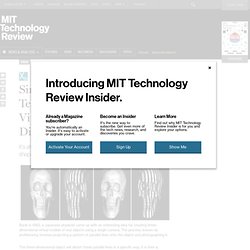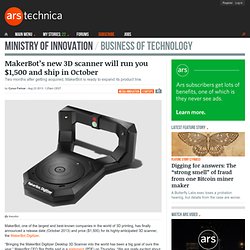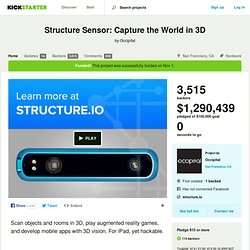

Simple Illumination Technique Creates 3-D Virtual Models Using One Digital Camera. Back in 1982, a Japanese physicist came up with an interesting idea for creating three-dimensional virtual models of real objects using a single camera.

The process, known as profilometry, involves projecting a pattern of parallel lines onto the object and photographing it. The three-dimensional object will distort these parallel lines in a specific way. It is then a relatively straightforward task for a computer to use these distortions to determine the shape. And photographing the object as it rotates allows the computer to build a 360-degree model. This process is fast, cheap, and easy to perform but it has one significant disadvantage. The reason is that the pattern of distortions is not unique in these more complex objects. 3D scanner. 3D scanner used to create the 3D animation A 3D scanner is a device that analyzes a real-world object or environment to collect data on its shape and possibly its appearance (i.e. color).

The collected data can then be used to construct digital three-dimensional models. Many different technologies can be used to build these 3D-scanning devices; each technology comes with its own limitations, advantages and costs. Many limitations in the kind of objects that can be digitized are still present, for example, optical technologies encounter many difficulties with shiny, mirroring or transparent objects. For example, industrial computed tomography scanning can be used to construct digital 3D models, applying non-destructive testing. Collected 3D data is useful for a wide variety of applications. Functionality[edit] Le scanner 3D pour dupliquer des objets façon Replicator de Star trek. Jadis, les imprimantes 3D étaient conçues pour des techniciens entraînés.

Aujourd’hui, elles sont presque aussi simples à utiliser qu’une imprimante à jet d’encre de bureau. Sauf qu’il faut dessiner et préparer le modèle en 3D. Cette étape nécessite encore une maîtrise d’un logiciel de modélisation 3D. C’est cette dernière barrière que MakerBot espère supprimer avec son nouveau scanner 3D Digitizer. Bienvenue dans le futur ! Quand vous l’associez avec une imprimante 3D, le Digitizer est presque un photocopieur pour objets. MakerBot Digitizer 3D Scanner. At SXSW, Bre Pettis, founder of MakerBot announced the new MakerBot Digitizer, a 3D scanner that allows you to scan just about any object and create a digital 3D version to manipulate and print on a MakerBot.

This is really exciting! This moves into the world where we’ll be scanning and printing things on our own at home. Not only is this great for design professionals, but imagine the possibilities for the rest of us? It’s a great step into the future. Sign up here to be notified when the MakerBot Digitizer is available. What do you think of the MakerBot Digitizer? MakerBot’s new 3D scanner will run you $1,500 and ship in October. MakerBot, one of the largest and best-known companies in the world of 3D printing, has finally announced a release date (October 2013) and price ($1,500) for its highly-anticipated 3D scanner, the MakerBot Digitizer.

“Bringing the MakerBot Digitizer Desktop 3D Scanner into the world has been a big goal of ours this year,” MakerBot CEO Bre Pettis said in a statement (PDF) on Thursday. “We are really excited about the MakerBot Digitizer. This is another innovative product for visionaries, early adopters, experimenters, educators, creative hobbyists, 3D sculptors, organic modelers, designers, and architects who want to be the first to become an expert in Desktop 3D Scanning.” Pettis first announced the product at the March 2013 SXSW conference in Austin, Texas. Meet the new hotness: All-in-one 3D printers and scanners. Structure Sensor: Capture the World in 3D by Occipital. The Structure Sensor gives mobile devices the ability to capture and understand the world in three dimensions.

With the Structure Sensor attached to your mobile device, you can walk around the world and instantly capture it in a digital form. This means you can capture 3D maps of indoor spaces and have every measurement in your pocket. You can instantly capture 3D models of objects and people for import into CAD and for 3D printing. You can play mind blowing augmented reality games where the real world is your game world. If you’re a developer, Structure gives you the ability to build mobile applications that interact with the three dimensional geometry of the real world for the very first time. The Structure Sensor has been designed from the ground up to be mobile. The Structure Sensor has a mobile-optimized range that begins at 40 centimeters and stretches to over 3.5 meters. Battery-powered Anodized aluminum chassis Dual infrared LEDs What does this mean in plain terms? 1. 2. 3. 4. 3-Sweep: Extracting Editable Objects from a Single Photo, SIGGRAPH ASIA 2013.
The Class of 2014. EmailShare 1374EmailShare New Leading-Edge Printers At MakerBot, we’ve been making professional-quality 3D printers affordable and accessible since 2009.

In that short time we’ve released four generations of 3D printers, helping unleash a worldwide 3D printing revolution in art and design, engineering and manufacturing, architecture, education, and more. Today we’re yet again defining the new standard in ease of use, quality, and reliability with the introduction of three new MakerBot Replicator 3D printers. We are proud to introduce the: